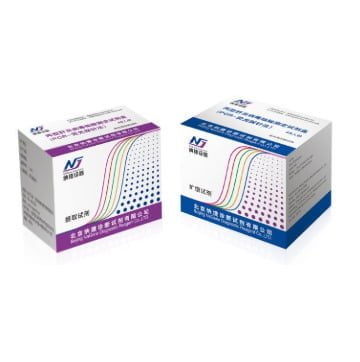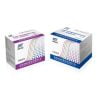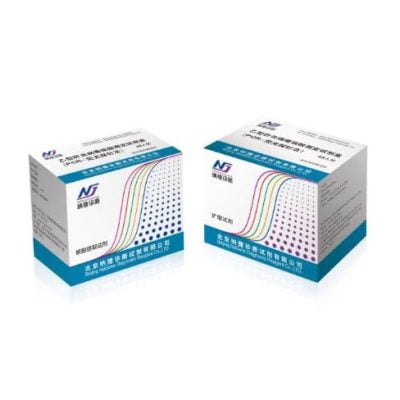Nome del prodotto
Kit per il test dell'acido nucleico del virus dell'epatite C (PCR-fluorescent probe method)
Packaging specification
48 T
introduzione al prodotto
- The kit is used for in vitro quantitative determination of hepatitis C virus (HCV) acido nucleico (RNA) in serum samples.
- It’s intended for patients requiring HCV infection testing and those undergoing antiviral treatment for hepatitis C.
- The kit can detect common clinical types of HCV, including types 1 A 6.
- It primarily monitors blood HCV RNA content and changes in patients with hepatitis C to evaluate treatment response and effectiveness.
- Tuttavia, the test should not be solely relied upon for evaluating a patient’s condition.
- A comprehensive evaluation, combining clinical performance and other laboratory test indicators, is necessary.
- This kit should not be used for blood source screening for HCV.
- The kit extracts HCV RNA from serum samples using a lysate containing magnetic beads and amplifies it in the same tube.
- HCV RNA is reverse transcribed into HCV cDNA by reverse transcriptase and quantified using the TaqMan probe technique in real-time assay.
- Calibration and quality control products for this kit are clinical serum samples containing inactivated hepatitis C virus.
- The kit monitors samples for PCR inhibitors by detecting internal labels to avoid false negatives.
Product Details
| Articolo | Product Information | Basis | Specification and Loading |
|---|---|---|---|
| RLB | Nucleic acid extraction reagent | HCV lysate (including magnetic beads) | Idrossido di sodio, potassium chloride, Tribase, and conformational magnetic beads |
| RWB | HCV rinse solution | Cloruro di potassio, sodium acetate | 25.0ml per bottle |
| 1 | PCR amplification reagent | The HCV RT-PCR reaction solution | Primers, sonde, deoxyribonucleoside triphosphates, and magnesium ions |
| 2 | HCV enzyme mixture | M-MLV reverse transcriptase, DNA polimerasi | UN 1001 |
| 3 | Calibrazione | HCV Calibration ① (1.0~3.0) 10^6 TU/ml | Fixed-value HCV-positive serum sample (inattivato) |
| 4 | Calibrazione | HCV Calibration ② (1.0~3.0) 10^2 IU/ml | Fixed-value HCV-positive serum sample (inattivato) |
| 5 | Calibrazione | HCV Calibration ③ (1.0~3.0) 10^4 IU/ml | Fixed-value HCV-positive serum sample (inattivato) |
| 6 | Calibrazione | HCV Calibration ④ (1.0~3.0) U/ml | Fixed-value HCV-positive serum sample (inattivato) |
| 7 | Quality control products | HCV strongly positive quality control products (0.5~5.0) U/ml | HCV-positive mixed serum samples (already inactivated) |
| 8 | Quality control products | HCV weakly positive quality control products (100~700) UI/ml | HCV-positive mixed serum samples (already inactivated) |
| 9 | Quality control products | HCV-negative quality control products | HCV-negative mixed serum samples (already inactivated) |
| 10 | Internal label | HCV internal label | Modello standard interno di acido nucleico |
Remarks:
UN. Parameters for calibrator products (①~④) and fixed values for strong positive and weak positive quality control products may vary between batches (all within the specified range). Refer to the attached page in the kit for details.
B. Do not mix components from kits with different batch numbers.
C. Self-provided test items include 0.2ml PCR reaction tubes, centrifuga, various specifications of pipettes and suction heads, magnetic frame, and the magnetic frame recommended by the company.
Storage Conditions and Validity:
- Kit per l'estrazione degli acidi nucleici: Store at 2 to 8°C.
- Kit di amplificazione PCR: Store at -20°C ± 5°C to avoid repeated freezing and thawing (non più di 3 volte).
- Validity period: This kit is valid for 12 mesi. Please use it within the validity period. Production date and expiration date can be found on the label.
- A simulated transportation experiment shows that transportation conditions will not affect the stability and validity of the product. Tuttavia, transportation time should not exceed 7 giorni.
Strumenti applicabili:
- SLAN-96P
- MX3000P/3005P
- AB17500 real-time fluorescent PCR instruments
Requisiti del campione:
- Applicable sample type: Siero.
- Raccolta campioni: Collect 2-5ml of venous blood using a sterile syringe and place it in a sterile drying tube (preferably with separation gel) at room temperature for 30 minuti. Centrifuge at 1500g for 35 minutes to separate serum and cells. Transfer the supernatant (avoiding red blood cells) into a sterile centrifuge tube without DNA and RNA enzymes for storage.
- Magazzinaggio: Serum samples should not be stored at 2-8°C for more than two weeks. Long-term storage below -20°C is acceptable, ma evita di congelare e scongelare ripetuti. Samples should be returned to room temperature before testing.
- Transportation: Specimens should be transported with dry ice or in a foam box, frozen, and sealed.
Method of Calibration:
(IO) Preparazione del reagente (Reagent Preparation Area):
- Take out various reagent components and allow them to reach room temperature.
- Preparation of Extract: Fully mix HCV lysate (RLB) containing magnetic beads before use. Mix at a ratio of (HCV lysate 1501/human + HCV internal standard 1.01/human). Immediately dispense 1501/well into the PCR amplification tube, ensuring the extract is at the bottom of the tube. If there are adhesive wall extract and magnetic beads, gently oscillate on the operating table to ensure they reach the bottom of the tube.
- Preparazione del reagente di amplificazione PCR: Prepare HCV RT-PCR reaction liquid and HCV enzyme mixture according to the number of samples, HCV negative quality control products, HCV weak positive quality control products, HCV strong positive quality control products, and HCV calibration products. Mix at a ratio of (38.01 of HCV RT-PCR reaction liquid/human + HCV enzyme mixture 2.01/human), and fully mix into PCR-Mix for immediate use.
(II) Nucleic Acid Extraction and Purification (Specimen Treatment Area):
- Aggiungere 1001 of samples to be tested or HCV, HCV, HCV, and HCV calibration. Gently blow and mix 2~3 times, then let stand at room temperature for 5 minuti.
- Transfer the PCR tube to the magnetic frame (recommended by the company) and stand for 3 minuti. Drain the supernatant with a pipette or negative pressure device, being careful not to remove the magnetic beads.
- Keep the PCR tube on the magnetic frame, aggiungere 2501 of HCV rinsing fluid (RWB) a ciascun pozzo, stand for 1 minuto, then drain the supernatant with a pipette or negative pressure device, ensuring that no residual fluid.
- Ripeti il passaggio 3 with RWB for another wash, being careful not to leave residual fluid at the bottom of the PCR tube.
(III) Expansion Reagent Addition (Specimen Treatment Area): Add prepared PCR-Mix at 401 per well to the PCR tube containing nucleic acid magnetic beads. Cover the amplification tube, and gently bounce to reverse the magnetic beads, ensuring the PCR-Mix is fully mixed. Centrifuge horizontally and transiently. Transfer the PCR reaction tubes to the detection area and place them on a fluorescence quantitative PCR instrument for detection.
(IV) Amplificazione PCR (Test Area):
- Place the PCR reaction tube into the amplicator, set HCV negative quality control, HCV weak positive quality control, HCV strong positive quality control, HCV calibration ①~④, and samples to be tested according to the corresponding order. Set the sample name and calibrated product concentration.
- Perform fluorescent PCR amplification procedure, using SLAN-96P as follows (MX3000P/3005P and ABI7500P are similar).
| Fare un passo | Temperatura (℃) | Tempo | Recurring Number |
|---|---|---|---|
| Reverse Transcription | 45 | 15 Minutes | 1 |
| Predenaturation | 95 | 5 Minutes | – |
| Denaturazione | 94 | 15 Seconds | 50 |
| Ricottura, Allungamento, and Fluorescence Acquisition | 58 | 45 Seconds | (Collecting Fluorescence) |
| Channel Selection | – | – | – |
Results Acquisition:
- Amplification Curve Description: Tipicamente, the amplification curve exhibits an S-type pattern.
- Baseline Setting: Choose a stable fluorescence background region as the baseline.
- Threshold Setting: It should surpass the highest point of the amplification curve of negative quality control products.
- Results Analysis: After setting the baseline and threshold line, analyze the results. Select the FAM channel for sample and quality control product test results; use the HEX or VIC channel as needed. (Refer to instrument operating instructions for specific settings).
Reference Value:
- The lower detection limit is 15 UI/ml, quantification limit is 50 UI/ml, with a target Ct value of 40, and an internal standard Ct of 40.
Experiment Effectiveness Judgment:
- All calibration products should exhibit positive linear correlation coefficients of ≥0.980.
- The negative quality control product must show no detection, with an internal standard Ct value of 40.
- The Ct value of strong positive quality control should be <32, ranging from (0.5 A 5.0) x 10^4 IU/ml; weakly positive QC Ct value should be <37, with quantification results ranging from (100 A 700) UI/ml.
- These requirements must be met within the same experiment; Altrimenti, results are considered invalid and require re-testing.
Interpretazione dei risultati dei test:
- For sample test results between 50~1.010^8 IU/ml, with an S-type curve, sample Ct value of 40, and internal standard Ct value of 40, results are valid and can be directly reported as positive with the corresponding concentration value.
- If the sample test result exceeds 1.010^8 IU/ml, dilute the sample and re-test.
- If sample test results are <50 IU/ml HCV RNA, with a sample Ct value of 40 and internal standard Ct value of 40, the viral load is low, and results can be reported directly, though the concentration is for reference only.
- If sample test results are <15 IU/ml HCV RNA, with a sample Ct value of 40 and internal standard Ct value of 40, the reported concentration is below the kit’s lower limit; if the internal standard is abnormal or missing, results are invalid and require investigation and re-testing.
Limitations of Detection Method:
- Clinical diagnosis and treatment should consider patient symptoms, medical history, and other tests.
- Incorrect sample handling may yield inaccurate results.
- Other sample types require validation before use.
- HCV RNA quantification depends on several factors.
- The detection kit is optimized for specific PCR instruments.
Product Performance Indicators:
- Tested against national standard material with a compliance rate of 100%.
- Quantification limit is 50 UI/ml, with a minimum detection limit of 15 UI/ml.
- Precision is evaluated with a coefficient of variation ≤5%.
- Linear range is 50 to 1.010^8 IU/ml, with a linear correlation coefficient of ≥0.980.
- Detects HCV types 1 A 6.
- Demonstrates specificity without cross-reactivity or interference from common substances.
- Comparative studies have shown reliability.
Attention:
- This kit is for in vitro testing. Review the manual before use.
- Ensure proper handling due to viral Estrazione dell'RNA and PCR amplification involvement.
- Follow established safety protocols.
- Condizioni di stoccaggio: Nucleic acid extraction kit stored at 2 to 8°C; PCR amplification kit stored at -20°C ± 5°C.
- Validity period is 12 mesi; check production and expiration dates.
- Transportation conditions should not exceed 7 giorni.
- Applicable sample type is serum; collect and process samples meticulously.
- Samples should not be stored for extended periods or subjected to repeated freezing/thawing.
- Proper transportation using cooling methods is essential.
- Reagent preparation involves balancing components to room temperature and mixing HCV lysate before use.
- PCR amplification reagent preparation should be done according to sample quantity.
- Nucleic acid extraction involves careful addition of samples and use of a magnetic frame.
- Expanding reagent addition and PCR amplification should follow precise steps.
- Fluorescent PCR amplification procedure requires adherence to instrument-specific protocols.
- Calibration of results and interpretation should be conducted meticulously.
- Test limitations, including potential mutations affecting results, must be considered.
- Product performance indicators and precautions should be followed closely for accurate testing.
- Continuous quality control and adherence to safety protocols are paramount for reliable results.



Recensioni
Non ci sono ancora recensioni.